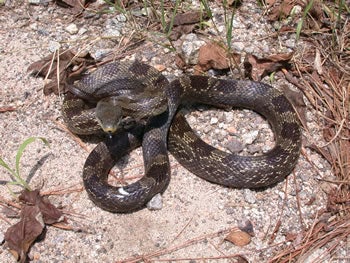SCIENTIFIC NAME:
Pantherophis spiloides
OTHER NAMES:
Chicken Snake or Oak Snake
STATUS:
Fairly common statewide. Lowest Conservation Concern.
DESCRIPTION:
A large, moderately stout snake attaining a maximum length of about 101 inches. The gray rat subspecies is slightly smaller than the black rat, attaining a maximum length of only about 84 inches. The black rat snake is more common in north Alabama, while the gray rat snake is more common in the south.
The gray rat snake has a gray background color with brown to dark gray blotches. Belly is white with boxlike dark gray to brownish blotches and dark spots that become stripes under the tail. Variations in color are noticeable in gray rat snakes with individuals in south Alabama being much lighter than those found elsewhere in the state.
The black rat snake has a black background color and may have traces of white between the scales. White marking may not be visible on all snakes. Some snakes have faintly visible dark blotches similar to the gray rat snake. Belly markings are same as gray rat snake.
DISTRIBUTION:
Statewide –Fairly common throughout.
HABITAT:
Occurs in most kinds of terrestrial habitats but attains greatest densities in areas where forests and farmland are generally intermixed and small rodents are relatively abundant. Will also be found in, or near, forested suburbs. Skillful climbers, rat snakes ascend trees or rafters of buildings in search of birds, eggs and mice. They may nest high in tree cavities, a position that may reduce mortality from fire ants and other ground-foraging predators.
FEEDING HABITS:
Adults mainly feed on mice and eggs, but will also eat birds, insects, rats, bats and other small mammals. Juveniles feed mainly on lizards and small frogs.
LIFE HISTORY AND ECOLOGY:
Diurnal in spring and fall, but becomes nocturnal in summer. Rat snakes mate from April to June and lay 5-30 eggs from June to August. Average clutch size is 12 to 18 and the eggs hatch in about 8 to 10 weeks. Hatchlings are 11to 16 inches long. Life span exceeds 20 years in captivity.
References:
Mount, Robert H. 1975. The Reptiles and Amphibians of Alabama. Auburn Printing Company, Alabama. 347 pp.
Knopf, Alfred A. 1979. The Audubon Society Field Guide to North American Reptiles and Amphibians. Chanticleer Press, Inc. New York. 743 pp.
Mirarchi, Ralph E. 2004. Alabama Wildlife, Volume One. The University of Alabama Press, Alabama. 209 pp.
Author:
Marisa Lee, AL Wildlife and Freshwater Fisheries








